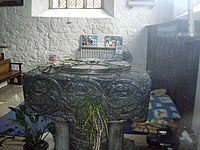User:Ericoides/Sandbox
A Tournai font is a baptismal font made during the 12th century in the Belgium town of Tournai. There are seven complete examples in England[1] and a disputed number in Europe: eighty according to one source,[2] or fifty in Northern France and Belgium and two in Germany according to another.[3] They are all fashioned out of Tournai marble, a dark form of limestone quarried near Tournai.
Background
[edit]A sculptural tradition, centred around Tournai, arose in the Scheldt valley from the 11th century onwards.[4] This was characterised by low relief, hard lines and the depiction of minute detail, these features arising from the hardness of the material used from the 12th century: Tournai marble.[4] As a sculptural style it is distinguished from the contemporary Meuse style, and it was used in sculpture in both Ghent and Bruges.[4]
Material and transport
[edit]The fonts are all sculpted from a single massive block[1] of blue black carboniferous Tournai limestone, known as "Tournai marble", quarried from the banks of the River Scheldt. The fonts, ready carved,{sfn|Tudor-Craig, p. 152}} were exported to England down the Scheldt and, owing to their weight and the difficulty of land transport, their ultimate destinations were either locations on the south or east coast, or places accessible by river.[1]
Belgium
[edit]The font at Onze Lieve Vrouwekerk, Dendermonde illustrates the story of Saint Peter's denial of Jesus.[3] The font at Wolvertem is unusuall in being round, square being the usual shape.[3]
England
[edit]Hampshire
[edit]The Tournai guild known as the Charité St Christophe, which has commercial links with Winchester, probably brought the four Hampshire fonts to the county,[3] most likely under the patronage of Henry of Blois.[5]

All Saints, East Meon
[edit]The font of c. 1130–40[6] in All Saints Church, East Meon was probably a gift to the church from Henry of Blois, Bishop of Winchester.[3] The Romanesque friezes on its sides depict the creation of Adam and Eve and the Temptation (N face); the Expulsion from the Garden of Eden and Adam being shown how to dig (E); and various animals, birds and dragons on the S and W faces.[6]

St Peter's, St Mary Bourne
[edit]
This is the largest of the English fonts.[1] A new base for the font was made in 1927 in Tournai.[1]
St Michael's, Southampton
[edit]The four faces of the font, located in the south-west corner of the church, each feature three medallion, on eleven of which animals are carved, with a single man carved on the twelvth. The pillars that support the font are not made of Tournai marble but of Purbeck marble.

Winchester Cathedral
[edit]The font, illustrating scenes from the life of St Nicholas of Myra, is the only one in the cathedral.
Lincolnshire
[edit]
Lincoln Cathedral
[edit]Alexander of Lincoln, Bishop of Lincoln, has usually been credited with the commissioning of the font in Lincoln Cathedral, but recent scholarship has suggested that it was in fact commissioned by his successor, Robert de Chesney.[7]

St Lawrence's, Thornton Curtis
[edit]Suffolk
[edit]St Peter's, Ipswich
[edit]The font is from c. 1170-90, resting on a 15th-century base, and is at the west end of the nave.[2] One each face of the font are three lions statant gardant, with pillars separating them. It has been argued that the position of the lions on each face, with the lion at each anglew facing outwards, was to avoid the lion pointing its bottom towards the altar, but this has been questioned.[2] The font used to be located close to the west respond of the south nave arcade.[2]
Fragment
[edit]A fragment of the bowl of a Tournai font was found in Ipswich and now resides in Ipswich Museum.[2]
Disputed examples
[edit]The original list of seven fonts was made by Allen and Kitchen in an 1894 article. There have subsequently been three suggested additions:
- Romsey Abbey, Hants. This existence of this font, apparently destroyed in a fire of 1850, has never been verified.[8]
- Iflley, Oxfordshire. This black limestone font is unlike any of the known Tornai fonts.[2]
- St Michael's, Boulge, Suffolk. Nikolaus Pevsner claims this is a Tournai font, albeit one with the relief statuary chipped off, but H. Munro Cautley states that it is Purbeck marble from around 1210.[1] Drake claims that the finish is too smooth for it ever to have had statuary.[8]
References
[edit]- Bibliography
- The Corpus of Romanesque Sculpture in Britain & Ireland, (CRSBI). "St Peter, Ipswich, Suffolk". Retrieved 29 September 2015.
- Drake, C. S. (2001). The Romanesque Fonts of Northern Europe and Scandinavia. London: The Boydell Press. ISBN 9780851158549.
- Harris, Brian L. (2006). Harris's Guide to Churches and Cathedrals: Discovering the Unique and Unusual in Over 500 Churches and Cathedrals. London: Random House. ISBN 9780091912512.
- Hourihane, Colum (2012). The Grove Encyclopedia of Medieval Art and Architecture, Volume 2. New York: OUP. ISBN 9780195395365.
- King, James F. (2002). "The Tournai Marble Baptismal Font of Lincoln Cathedral". Journal of the British Archaeological Association. 155: 1–21.
- Pevsner, Nikolaus; Lloyd, David (2002). The Buildings of England: Hampshire and the Isle of Wight. New Haven and London: Yale University Press. ISBN 0-300-09606-2.
- Tudor-Craig, Pamela (2005). "The Fonts of St George's Chapel". In Saul, Nigel (ed.). St George's Chapel, Windsor, in the Fourteenth Century. London: The Boydell Press. ISBN 9781843831174.
- Wadsworth, Peter. The Tournai Font. All Saints' Church parish office, East Meon.
